Esophageal Squamous Cell Carcinoma Is Accompanied by Local and Systemic Changes in L-arginine/NO Pathway
Abstract
1. Introduction
2. Results
2.1. Systemic Concentrations of L-arginine/NO Pathway Metabolites
2.1.1. L-arginine/NO Pathway Metabolites in ESCC and Benign Conditions
2.1.2. Association of L-arginine/NO Pathway Metabolites with ESCC Advancement
2.1.3. L-arginine/NO Pathway Metabolites as Differential Markers
2.1.4. Interrelationship between Systemic Concentrations of L-arginine/NO Pathway Metabolites
2.1.5. Interplay Between L-arginine/NO Pathway Metabolites and Circulating Cytokines and Growth Factors
2.2. Transcriptional Analysis of Local Expression of Key L-arginine/NO Pathway Enzymes
2.2.1. Pairwise Analysis of Enzyme Expression in Tumor and Adjacent Tissue
2.2.2. Association between Fold Change in Enzyme Expression and ESCC Pathology
2.2.3. Interrelationship between Local Expression Levels of L-arginine/NO Pathway Enzymes
2.2.4. Correlation between Local Expression Levels of L-arginine/NO Pathway Enzymes and Circulating Cytokines, Chemokines, and Growth Factors as Well as Systemic Concentrations of Pathway Metabolites
3. Discussion
4. Materials and Methods
4.1. Sample Collection
4.2. Study Population—Metabolomic Analysis
4.3. Study Population—Transcriptomic Analysis
4.4. Ethical Considerations
4.5. Analytical Methods
4.5.1. Metabolomic Analysis
Chemicals
LC-QTOF-MS Analysis of Selected L-arginine/NO Pathway Metabolites
4.5.2. Multiplex Analysis
4.5.3. Transcriptomic Analysis
4.6. Statistical Analysis
Author Contributions
Funding
Acknowledgments
Conflicts of Interest
Abbreviations
| ADMA | Asymmetric dimethylarginine |
| Arg | Arginine |
| ARG | Arginase |
| ASS1 | Argininosuccinate lyase |
| AUC | Area under receiver operating characteristics (ROC) curve |
| CAT | Cationic amino acid transporter |
| Cit | Citrulline |
| CRC | Colorectal cancer |
| CTAK | C-C motif chemokine ligand 27 (CCL27) |
| DDAH | Dimethylarginine dimethylaminohydrolase |
| DMA | Dimethylamine |
| EOX | Eotaxin-1 |
| ESCC | Esophageal squamous cell carcinoma |
| FGF2 | Fibroblast growth factor β |
| G-CSF | Granulocyte colony-stimulating factor |
| GM-CSF | Granulocyte-macrophage colony-stimulating factor |
| GROa | Growth-regulated alpha protein (CXCL1) |
| HGF | Hepatocyte growth factor |
| IFN | Interferon |
| IL | Interleukin |
| IL-1ra | Interleukin-1 receptor antagonist |
| IL-2Rα | Interleukin 2 receptor subunit α |
| IP-10 | Interferon gamma-induced protein 10 (CXCL10) |
| LC-MS/MS | Liquid Chromatography with tandem mass spectrometry |
| LIF | Leukemia inhibitory factor |
| MCP-1 | Monocyte chemoattractant protein 1 |
| MIF | Macrophage migration inhibitory factor |
| MIG | Monokine induced by gamma interferon (CXCL9) |
| MIP | Macrophage inflammatory protein |
| NOS | Nitric oxide synthase |
| NRQ | Normalized relative quantity |
| ODC | Ornithine decarboxylase |
| Orn | Ornithine |
| PDGF-BB | Platelet-derived growth factor BB |
| PRMT | Protein arginine N-methyltransferase |
| RANTES | “Regulated on activation, normal T-cell expressed and secreted” (CCL5) |
| SCF | Stem cell factor |
| SCGFβ | Stem cell growth factor β |
| SDF-1α | Stromal cell-derived factor 1α |
| SDMA | Symmetric dimethylarginine |
| TNFα | Tumor necrosis factor α |
| TNM | Tumor-node-metastasis cancer staging system |
| TRAIL | Tumor necrosis factor (TNF)-related apoptosis inducing ligand |
| VEGF-A | Vascular endothelial growth factor A |
| β-NGF | Nerve growth factor β |
References
- Abnet, C.C.; Arnold, M.; Wei, W. Epidemiology of Esophageal Squamous Cell Carcinoma. Gastroenterology 2018, 154, 360–373. [Google Scholar] [CrossRef] [PubMed]
- Kumar, K.V.V.; Sagar, R.; Mathew, J. Squamous cell carcinoma: Esophagus. In Squamous Cell Carcinoma—Hallmark and Treatment Modalities; Daaboul, H.E., Ed.; IntechOpen Ltd.: London, UK, 2019. [Google Scholar] [CrossRef]
- Yang, J.W.; Choi, Y.-L. Genomic profiling of esophageal squamous cell carcinoma (ESCC)—Basis for precision medicine. Pathol. Res. Pract. 2017, 213, 836–841. [Google Scholar] [CrossRef] [PubMed]
- Hanahan, D.; Weinberg, R.A. Hallmarks of Cancer: The Next Generation. Cell 2011, 144, 646–674. [Google Scholar] [CrossRef] [PubMed]
- Faubert, B.; Solmonson, A.; de Berardinis, R.J. Metabolic reprogramming and cancer progression. Science 2020, 368, e5473. [Google Scholar] [CrossRef] [PubMed]
- Bednarz-Misa, I.; Fortuna, P.; Diakowska, D.; Jamrozik, N.; Krzystek-Korpacka, M. Distinct Local and Systemic Molecular Signatures in the Esophageal and Gastric Cancers: Possible Therapy Targets and Biomarkers for Gastric Cancer. Int. J. Mol. Sci. 2020, 21, 4509. [Google Scholar] [CrossRef] [PubMed]
- Bednarz-Misa, I.; Fleszar, M.G.; Zawadzki, M.; Kapturkiewicz, B.; Kubiak, A.; Neubauer, K.; Witkiewicz, W.; Krzystek-Korpacka, M. L-Arginine/NO Pathway Metabolites in Colorectal Cancer: Relevance as Disease Biomarkers and Predictors of Adverse Clinical Outcomes Following Surgery. J. Clin. Med. 2020, 9, 1782. [Google Scholar] [CrossRef]
- Krzystek-Korpacka, M.; Fleszar, M.G.; Bednarz-Misa, I.; Lewandowski, Ł.; Szczuka, I.; Kempiński, R.; Neubauer, K. Transcriptional and Metabolomic Analysis of L-Arginine/Nitric Oxide Pathway in Inflammatory Bowel Disease and Its Association with Local Inflammatory and Angiogenic Response: Preliminary Findings. Int. J. Mol. Sci. 2020, 21, 1641. [Google Scholar] [CrossRef] [PubMed]
- Keshet, R.; Erez, A. Arginine and the metabolic regulation of nitric oxide synthesis in cancer. Dis. Model. Mech. 2018, 11, dmm033332. [Google Scholar] [CrossRef]
- Morris, S.M. Arginine Metabolism: Boundaries of Our Knowledge. J. Nutr. 2007, 137, S1602–S1609. [Google Scholar] [CrossRef]
- Szefel, J.; Danielak, A.; Kruszewski, W.J. Metabolic pathways of L-arginine and therapeutic consequences in tumors. Adv. Med. Sci. 2019, 64, 104–110. [Google Scholar] [CrossRef]
- Zou, S.; Wang, X.; Liu, P.; Ke, C.; Xu, S. Arginine metabolism and deprivation in cancer therapy. Biomed. Pharmacother. 2019, 118, 109210. [Google Scholar] [CrossRef] [PubMed]
- Kus, K.; Kij, A.; Zakrzewska, A.; Jasztal, A.; Stojak, M.; Walczak, M.; Chlopicki, S. Alterations in arginine and energy metabolism, structural and signalling lipids in metastatic breast cancer in mice detected in plasma by targeted metabolomics and lipidomics. Breast Cancer Res. 2018, 20, 148. [Google Scholar] [CrossRef] [PubMed]
- Fulton, M.D.; Brown, T.; Zheng, Y.G. The Biological Axis of Protein Arginine Methylation and Asymmetric Dimethylarginine. Int. J. Mol. Sci. 2019, 20, 3322. [Google Scholar] [CrossRef] [PubMed]
- Torresano, L.; Nuevo-Tapioles, C.; Santacatterina, F.; Cuezva, J.M. Metabolic reprogramming and disease progression in cancer patients. Biochim. Biophys. Acta Mol. Basis Dis. 2020, 1866, 165721. [Google Scholar] [CrossRef] [PubMed]
- Yoshida, M.; Hayashi, H.; Taira, M.; Isono, K. Elevated expression of the ornithine decarboxylase gene in human esophageal cancer. Cancer Res. 1992, 52, 6671–6675. [Google Scholar] [PubMed]
- He, W.; Roh, E.; Yao, K.; Liu, K.; Meng, X.; Liu, F.; Wang, P.; Bode, A.M.; Surh, Y.-J. Targeting ornithine decarboxylase (ODC) inhibits esophageal squamous cell carcinoma progression. npj Precis. Oncol. 2017, 1, 13. [Google Scholar] [CrossRef]
- Gerner, E.W.; Bruckheimer, E.; Cohen, A. Cancer pharmacoprevention: Targeting polyamine metabolism to manage risk factors for colon cancer. J. Boil. Chem. 2018, 293, 18770–18778. [Google Scholar] [CrossRef]
- Auvinen, M.; Laine, A.; Paasinen-Sohns, A.; Kangas, A.; Kangas, L.; Saksela, O.; Andersson, L.C.; Hölttä, E. Human ornithine decarboxylase-overproducing NIH3T3 cells induce rapidly growing, highly vascularized tumors in nude mice. Cancer Res. 1997, 57, 3016–3025. [Google Scholar]
- Gurpinar, E.; Grizzle, W.E.; Piazza, G. COX-Independent Mechanisms of Cancer Chemoprevention by Anti-Inflammatory Drugs. Front. Oncol. 2013, 3, 181. [Google Scholar] [CrossRef]
- Meyskens, F.L.; McLaren, C.E.; Pelot, D.; Fujikawa-Brooks, S.; Carpenter, P.M.; Hawk, E.; Kelloff, G.; Lawson, M.J.; Kidao, J.; McCracken, J.; et al. Difluoromethylornithine Plus Sulindac for the Prevention of Sporadic Colorectal Adenomas: A Randomized Placebo-Controlled, Double-Blind Trial. Cancer Prev. Res. 2008, 1, 32–38. [Google Scholar] [CrossRef]
- Bednarz-Misa, I.; Diakowska, D.; Krzystek-Korpacka, M.; Diakowska, R.; Misa, B.; Korpacka, K. Local and Systemic IL-7 Concentration in Gastrointestinal-Tract Cancers. Medicina 2019, 55, 262. [Google Scholar] [CrossRef] [PubMed]
- Dakubo, G.D.; Jakupciak, J.P.; Birch-Machin, M.A.; Parr, R.L. Clinical implications and utility of field cancerization. Cancer Cell Int. 2007, 7, 2. [Google Scholar] [CrossRef] [PubMed]
- Patel, A.; Tripathi, G.; Gopalakrishnan, K.; Williams, N.; Arasaradnam, R.P. Field cancerisation in colorectal cancer: A new frontier or pastures past? World J. Gastroenterol. 2015, 21, 3763–3772. [Google Scholar] [CrossRef] [PubMed]
- Hulin, J.-A.; Gubareva, E.A.; Jarzebska, N.; Rodionov, R.N.; Mangoni, A.A.; Tommasi, S. Inhibition of Dimethylarginine Dimethylaminohydrolase (DDAH) Enzymes as an Emerging Therapeutic Strategy to Target Angiogenesis and Vasculogenic Mimicry in Cancer. Front. Oncol. 2020, 9, 1455. [Google Scholar] [CrossRef]
- Buijs, N.; Oosterink, J.E.; Jessup, M.; Schierbeek, H.; Stolz, D.B.; Houdijk, A.P.; Geller, D.A.; van Leeuwen, P.A. A new key player in VEGF-dependent angiogenesis in human hepatocellular carcinoma: Dimethylarginine dimethylaminohydrolase 1. Angiogenesis 2017, 20, 557–565. [Google Scholar] [CrossRef] [PubMed]
- Sorrenti, V.; Vanella, L.; di Giacomo, C.; Acquaviva, R.; Santangelo, R.; Cardile, V.; Barbagallo, I.A.; Abraham, N.G. The DDAH/NOS pathway in human prostatic cancer cell lines: Antiangiogenic effect of L-NAME. Int. J. Oncol. 2011, 39, 1303–1310. [Google Scholar] [CrossRef] [PubMed]
- Tain, Y.-L.; Hsu, C.-N. Toxic Dimethylarginines: Asymmetric Dimethylarginine (ADMA) and Symmetric Dimethylarginine (SDMA). Toxins 2017, 9, 92. [Google Scholar] [CrossRef]
- Brankovic, B.; Stanojevic, G.; Stojanovic, I.; Veljkovic, A.; Kocic, G.; Janosevic, P.; Nestorovic, M.; Petrovic, D.; Djindjic, B.; Pavlovic, D.; et al. Nitric oxide synthesis modulation—A possible diagnostic and therapeutic target in colorectal cancer. J. BUON 2017, 22, 162–169. [Google Scholar]
- Li, H.; Zhou, Y.; Zhao, A.; Qiu, Y.; Xie, G.; Jiang, Q.; Zheng, X.; Zhong, W.; Sun, X.; Zhou, Z.; et al. Asymmetric dimethylarginine attenuates serum starvation-induced apoptosis via suppression of the Fas (APO-1/CD95)/JNK (SAPK) pathway. Cell Death Dis. 2013, 4, e830. [Google Scholar] [CrossRef]
- Yuan, M.; Zhu, H.; Xu, J.; Zheng, Y.; Cao, X.; Liu, Q. Tumor-Derived CXCL1 Promotes Lung Cancer Growth via Recruitment of Tumor-Associated Neutrophils. J. Immunol. Res. 2016, 2016, 1–11. [Google Scholar] [CrossRef]
- Wang, N.; Liu, W.; Zheng, Y.-F.; Wang, S.; Yang, B.; Li, M.; Song, J.; Zhang, F.; Zhang, X.; Wang, Q.; et al. CXCL1 derived from tumor-associated macrophages promotes breast cancer metastasis via activating NF-κB/SOX4 signaling. Cell Death Dis. 2018, 9, 880. [Google Scholar] [CrossRef] [PubMed]
- Yu, S.; Yi, M.; Xu, L.; Qin, S.; Li, A.; Wu, K. CXCL1 as an Unfavorable Prognosis Factor Negatively Regulated by DACH1 in Non-small Cell Lung Cancer. Front. Oncol. 2020, 9, 9. [Google Scholar] [CrossRef] [PubMed]
- Yang, Y.; Bedford, M.T. Protein arginine methyltransferases and cancer. Nat. Rev. Cancer 2012, 13, 37–50. [Google Scholar] [CrossRef]
- Li, X.; Wang, C.; Jiang, H.; Luo, C. A patent review of arginine methyltransferase inhibitors (2010–2018). Expert Opin. Ther. Patents 2019, 29, 97–114. [Google Scholar] [CrossRef] [PubMed]
- Musiani, D.; Giambruno, R.; Massignani, E.; Ippolito, M.R.; Maniaci, M.; Jammula, S.; Manganaro, D.; Cuomo, A.; Nicosia, L.; Pasini, D.; et al. PRMT1 Is Recruited via DNA-PK to Chromatin Where It Sustains the Senescence-Associated Secretory Phenotype in Response to Cisplatin. Cell Rep. 2020, 30, 1208–1222. [Google Scholar] [CrossRef]
- Wei, H.-H.; Fan, X.-J.; Hu, Y.; Tian, X.-X.; Guo, M.; Fang, Z.-Y.; Wu, P.; Gao, S.-X.; Peng, C.; Yang, Y.; et al. A systematic survey of PRMT interactomes reveals key roles of arginine methylation in the global control of RNA splicing and translation. BioRxiv 2019. [Google Scholar] [CrossRef]
- Zhou, W.; Yue, H.; Li, C.; Chen, H.; Yuan, Y. Protein arginine methyltransferase 1 promoted the growth and migration of cancer cells in esophageal squamous cell carcinoma. Tumor Boil. 2015, 37, 2613–2619. [Google Scholar] [CrossRef]
- Zhao, Y.; Lu, Q.; Li, C.; Wang, X.; Jiang, L.; Huang, L.; Wang, C.; Chen, H. PRMT1 regulates the tumour-initiating properties of esophageal squamous cell carcinoma through histone H4 arginine methylation coupled with transcriptional activation. Cell Death Dis. 2019, 10, 359. [Google Scholar] [CrossRef]
- Chuang, C.-Y.; Chang, C.-P.; Lee, Y.-J.; Lin, W.-L.; Wu, J.-S.; Cheng, Y.-W.; Li, C. PRMT1 expression is elevated in head and neck cancer and inhibition of protein arginine methylation by adenosine dialdehyde or PRMT1 knockdown downregulates proliferation and migration of oral cancer cells. Oncol. Rep. 2017, 38, 1115–1123. [Google Scholar] [CrossRef]
- Xiao, W.; Chen, X.; Liu, L.; Shu, Y.; Zhang, M.; Zhong, Y. Role of protein arginine methyltransferase 5 in human cancers. Biomed. Pharmacother. 2019, 114, 108790. [Google Scholar] [CrossRef]
- Ichikawa, T.; Shanab, O.; Nakahata, S.; Shimosaki, S.; Manachai, N.; Ono, M.; Iha, H.; Shimoda, K.; Morishita, K. Novel PRMT5-mediated arginine methylations of HSP90A are essential for maintenance of HSP90A function in NDRG2low ATL and various cancer cells. Biochim. Biophys. Acta Bioenerg. 2019, 1867, 118615. [Google Scholar] [CrossRef] [PubMed]
- Kim, E.; Jang, J.; Park, J.G.; Kim, K.-H.; Yoon, K.; Yoo, B.C.; Cho, J.Y. Protein Arginine Methyltransferase 1 (PRMT1) Selective Inhibitor, TC-E 5003, Has Anti-Inflammatory Properties in TLR4 Signaling. Int. J. Mol. Sci. 2020, 21, 3058. [Google Scholar] [CrossRef] [PubMed]
- Clemente, G.S.; van Waarde, A.; Antunes, I.F.; Dömling, A.; Elsinga, P.H. Arginase as a Potential Biomarker of Disease Progression: A Molecular Imaging Perspective. Int. J. Mol. Sci. 2020, 21, 5291. [Google Scholar] [CrossRef] [PubMed]
- Wu, Y.; He, C.; Hu, S.; Hu, Z.; Li, Y.; Xing, X.; Du, X. Downregulation of ARG2 inhibits growth of colorectal cancer cells and increases expression of the CD3ζ chain in co-cultured T-cells. Int. J. Clin. Exp. Med. 2019, 12, 6946–6957. [Google Scholar]
- Miret, J.J.; Kirschmeier, P.; Koyama, S.; Zhu, M.; Li, Y.Y.; Naito, Y.; Wu, M.; Malladi, V.S.; Huang, W.; Walker, W.; et al. Suppression of Myeloid Cell Arginase Activity leads to Therapeutic Response in a NSCLC Mouse Model by Activating Anti-Tumor Immunity. J. Immunother. Cancer 2019, 7, 32. [Google Scholar] [CrossRef]
- Pedrosa, L.; Esposito, F.M.; Thomson, T.M.; Maurel, J. The Tumor Microenvironment in Colorectal Cancer Therapy. Cancers 2019, 11, 1172. [Google Scholar] [CrossRef]
- Choi, W.; Lee, J.; Lee, J.; Lee, S.H.; Kim, S. Hepatocyte Growth Factor Regulates Macrophage Transition to the M2 Phenotype and Promotes Murine Skeletal Muscle Regeneration. Front. Physiol. 2019, 10, 914. [Google Scholar] [CrossRef]
- Setty, B.A.; Smiley, N.P.; Pool, C.M.; Jin, Y.; Liu, Y.; Nelin, L.D. Hypoxia-induced proliferation of HeLa cells depends on epidermal growth factor receptor-mediated arginase II induction. Physiol. Rep. 2017, 5, e13175. [Google Scholar] [CrossRef]
- Sormendi, S.; Wielockx, B. Hypoxia Pathway Proteins as Central Mediators of Metabolism in the Tumor Cells and Their Microenvironment. Front. Immunol. 2018, 9, 40. [Google Scholar] [CrossRef]
- Kumar, V.; Gabrilovich, D.I. Hypoxia-inducible factors in regulation of immune responses in tumour microenvironment. Immunology 2014, 143, 512–519. [Google Scholar] [CrossRef]
- Cheng, X.; Wang, H.; Zhang, X.; Zhao, S.; Zhou, Z.; Mu, X.; Zhao, C.; Teng, W. The Role of SDF-1/CXCR4/CXCR7 in Neuronal Regeneration after Cerebral Ischemia. Front. Mol. Neurosci. 2017, 11, 590. [Google Scholar] [CrossRef] [PubMed]
- Delage, B.; Fennell, D.A.; Nicholson, L.; McNeish, I.; Lemoine, N.R.; Crook, T.; Szlosarek, P.W. Arginine deprivation and argininosuccinate synthetase expression in the treatment of cancer. Int. J. Cancer 2010, 126, 2762–2772. [Google Scholar] [CrossRef] [PubMed]
- Miyamoto, T.; Lo, P.H.Y.; Saichi, N.; Ueda, K.; Hirata, M.; Tanikawa, C.; Matsuda, K. Argininosuccinate synthase 1 is an intrinsic Akt repressor transactivated by p53. Sci. Adv. 2017, 3, e1603204. [Google Scholar] [CrossRef]
- Huang, H.-Y.; Wu, W.-R.; Wang, Y.-H.; Wang, J.-W.; Fang, F.-M.; Tsai, J.-W.; Li, S.-H.; Hung, H.-C.; Yu, S.-C.; Lan, J.; et al. ASS1 as a Novel Tumor Suppressor Gene in Myxofibrosarcomas: Aberrant Loss via Epigenetic DNA Methylation Confers Aggressive Phenotypes, Negative Prognostic Impact, and Therapeutic Relevance. Clin. Cancer Res. 2013, 19, 2861–2872. [Google Scholar] [CrossRef] [PubMed]
- Moye, L.M.; Liu, Y.; Coarfa, C.; Putluri, N.; Rhoads, J.M. Plasma Urea Cycle Metabolites May Be Useful Biomarkers in Children With Eosinophilic Esophagitis. Front. Pediatr. 2019, 6, 423. [Google Scholar] [CrossRef] [PubMed]
- Peñuelas, S.; Anido, J.; Prieto-Sánchez, R.M.; Folch, G.; Barba, I.; Cuartas, I.; García-Dorado, D.; Poca, M.-A.; Sahuquillo, J.; Baselga, J.; et al. TGF-β Increases Glioma-Initiating Cell Self-Renewal through the Induction of LIF in Human Glioblastoma. Cancer Cell 2009, 15, 315–327. [Google Scholar] [CrossRef] [PubMed]
- Albrengues, J.; Bourget, I.; Pons, C.; Butet, V.; Hofman, P.; Tartare-Deckert, S.; Féral, C.C.; Meneguzzi, G.; Gaggioli, C. LIF Mediates Proinvasive Activation of Stromal Fibroblasts in Cancer. Cell Rep. 2014, 7, 1664–1678. [Google Scholar] [CrossRef]
- Nicola, N.A.; Babon, J.J. Leukemia inhibitory factor (LIF). Cytokine Growth Factor Rev. 2015, 26, 533–544. [Google Scholar] [CrossRef]
- Pascual-García, M.; Bonfill-Teixidor, E.; Planas-Rigol, E.; Rubio-Perez, C.; Iurlaro, R.; Arias, A.; Cuartas, I.; Sala-Hojman, A.; Escudero, L.; Martínez-Ricarte, F.; et al. LIF regulates CXCL9 in tumor-associated macrophages and prevents CD8+ T cell tumor-infiltration impairing anti-PD1 therapy. Nat. Commun. 2019, 10, 2416. [Google Scholar] [CrossRef]
- Mazzoldi, E.L.; Pavan, S.; Pilotto, G.; Leone, K.; Pagotto, A.; Frezzini, S.; Nicoletto, M.O.; Amadori, A.; Pastò, A. A juxtacrine/paracrine loop between C-Kit and stem cell factor promotes cancer stem cell survival in epithelial ovarian cancer. Cell Death Dis. 2019, 10, 412. [Google Scholar] [CrossRef]
- Mego, M.; Cholujova, D.; Minárik, G.; Sedlackova, T.; Gronesova, P.; Karaba, M.; Benca, J.; Cingelova, S.; Cierna, Z.; Manasova, D.; et al. CXCR4-SDF-1 interaction potentially mediates trafficking of circulating tumor cells in primary breast cancer. BMC Cancer 2016, 16, 127. [Google Scholar] [CrossRef] [PubMed]
- Levina, V.; Marrangoni, A.M.; Demarco, R.; Gorelik, E.; Lokshin, A.E. Drug-Selected Human Lung Cancer Stem Cells: Cytokine Network, Tumorigenic and Metastatic Properties. PLoS ONE 2008, 3, e3077. [Google Scholar] [CrossRef] [PubMed]
- Yu, J.; Zhao, J.; Zhang, M.; Guo, J.; Liu, X.; Liu, L. Metabolomics studies in gastrointestinal cancer: A systematic review. Expert Rev. Gastroenterol. Hepatol. 2019, 14, 9–25. [Google Scholar] [CrossRef] [PubMed]
- Konya, H.; Miuchi, M.; Satani, K.; Matsutani, S.; Yano, Y.; Tsunoda, T.; Ikawa, T.; Matsuo, T.; Ochi, F.; Kusunoki, Y.; et al. Asymmetric dimethylarginine, a biomarker of cardiovascular complications in diabetes mellitus. World J. Exp. Med. 2015, 5, 110–119. [Google Scholar] [CrossRef] [PubMed]
- Rysz, J.; Gluba-Brzozka, A.; Franczyk, B.; Jablonowski, Z.; Cialkowska-Rysz, A. Novel Biomarkers in the Diagnosis of Chronic Kidney Disease and the Prediction of Its Outcome. Int. J. Mol. Sci. 2017, 18, 1702. [Google Scholar] [CrossRef]
- Di Franco, M.; Lucchino, B.; Conti, F.; Valesini, G.; Spinelli, F.R. Asymmetric Dimethyl Arginine as a Biomarker of Atherosclerosis in Rheumatoid Arthritis. Mediat. Inflamm. 2018, 2018, 1–13. [Google Scholar] [CrossRef]
- Fleszar, M.G.; Wiśniewski, J.; Zboch, M.; Diakowska, R.; Gamian, A.; Krzystek-Korpacka, M. Targeted metabolomic analysis of nitric oxide/L-arginine pathway metabolites in dementia: Association with pathology, severity, and structural brain changes. Sci. Rep. 2019, 9, 13764. [Google Scholar] [CrossRef]
- Fleszar, M.G.; Wisniewski, J.; Krzystek-Korpacka, M.; Misiak, B.; Frydecka, D.; Piechowicz, J.; Lorenc-Kukuła, K.; Gamian, A. Quantitative Analysis of l-Arginine, Dimethylated Arginine Derivatives, l-Citrulline, and Dimethylamine in Human Serum Using Liquid Chromatography–Mass Spectrometric Method. Chromatographia 2018, 81, 911–921. [Google Scholar] [CrossRef]
- Krzystek-Korpacka, M.; Wiśniewski, J.; Fleszar, M.G.; Bednarz-Misa, I.; Bronowicka-Szydełko, A.; Gacka, M.; Masłowski, L.; Kędzior, K.; Witkiewicz, W.; Gamian, A. Metabolites of the Nitric Oxide (NO) Pathway Are Altered and Indicative of Reduced NO and Arginine Bioavailability in Patients with Cardiometabolic Diseases Complicated with Chronic Wounds of Lower Extremities: Targeted Metabolomics Approach (LC-MS/MS). Oxidative Med. Cell. Longev. 2019, 2019, 5965721. [Google Scholar] [CrossRef]
- Chachaj, A.; Wisniewski, J.; Rybka, J.; Butrym, A.; Biedron, M.; Krzystek-Korpacka, M.; Fleszar, M.G.; Karczewski, M.; Wrobel, T.; Mazur, G.; et al. Asymmetric and symmetric dimethylarginines and mortality in patients with hematological malignancies—A prospective study. PLoS ONE 2018, 13, e0197148. [Google Scholar] [CrossRef]
- Vandesompele, J.; de Preter, K.; Pattyn, F.; Poppe, B.; van Roy, N.; de Paepe, A.; Speleman, F. Accurate normalization of real-time quantitative RT-PCR data by geometric averaging of multiple internal control genes. Genome Boil. 2002, 3, 34. [Google Scholar] [CrossRef]
- Akoğlu, H. User’s guide to correlation coefficients. Turk. J. Emerg. Med. 2018, 18, 91–93. [Google Scholar] [CrossRef] [PubMed]
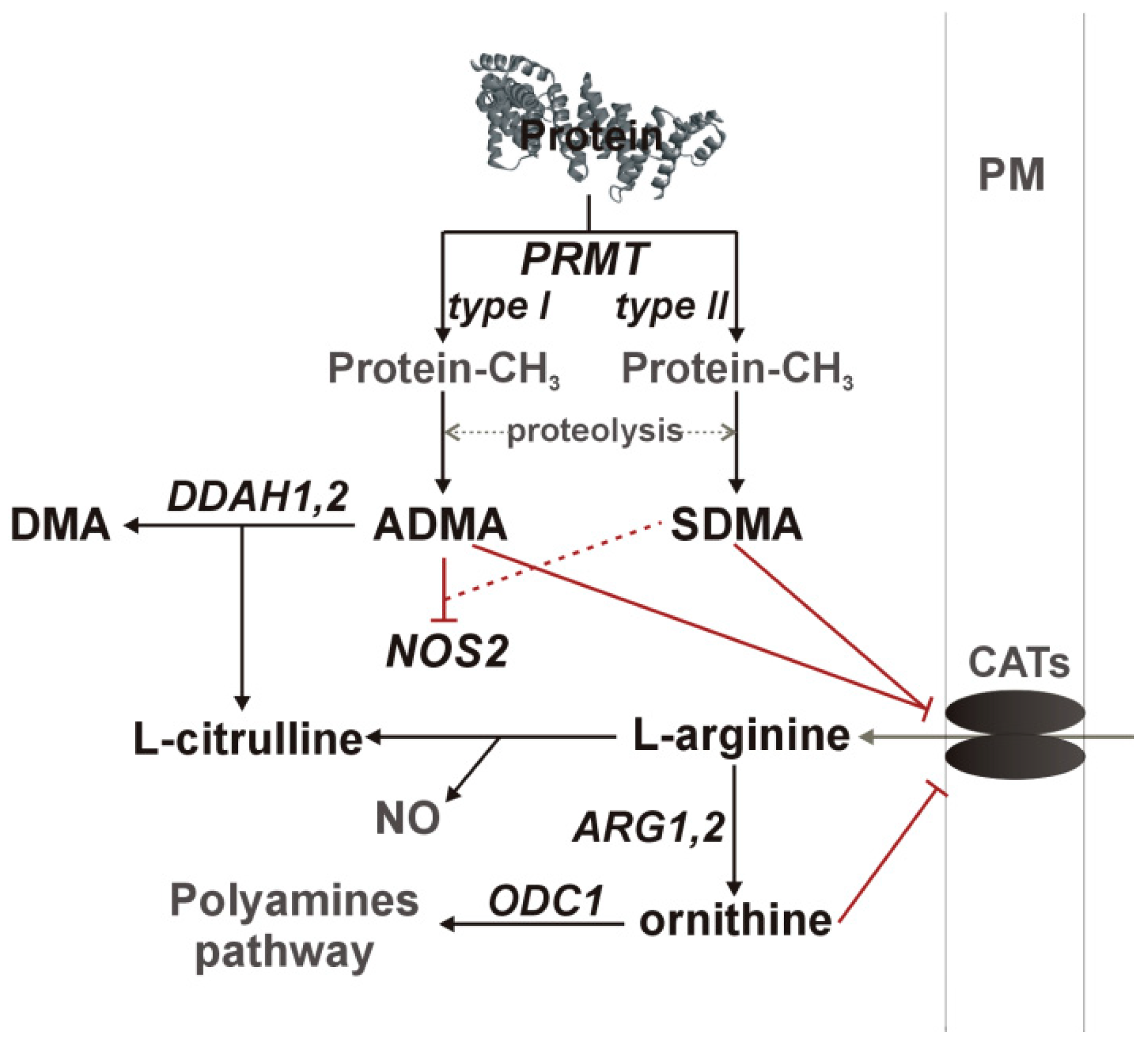
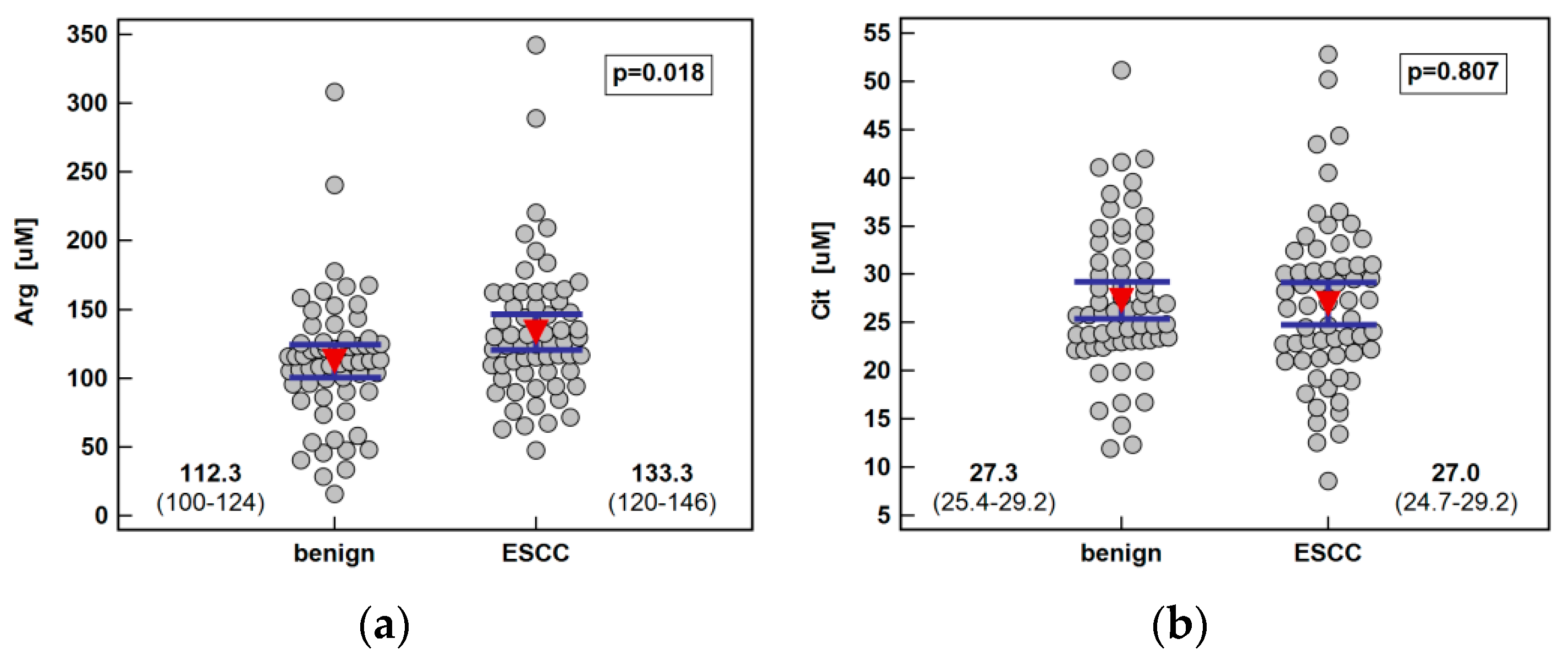
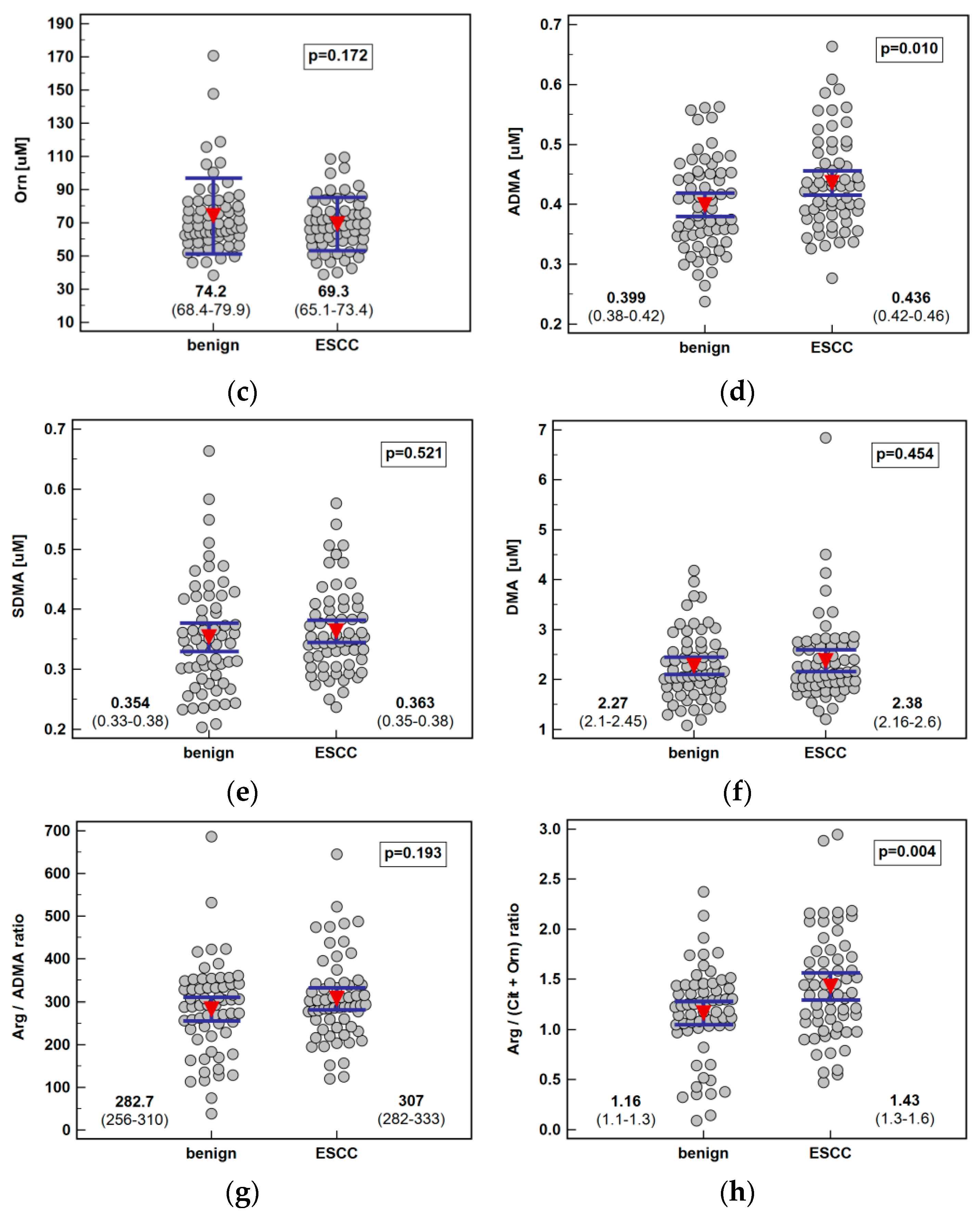
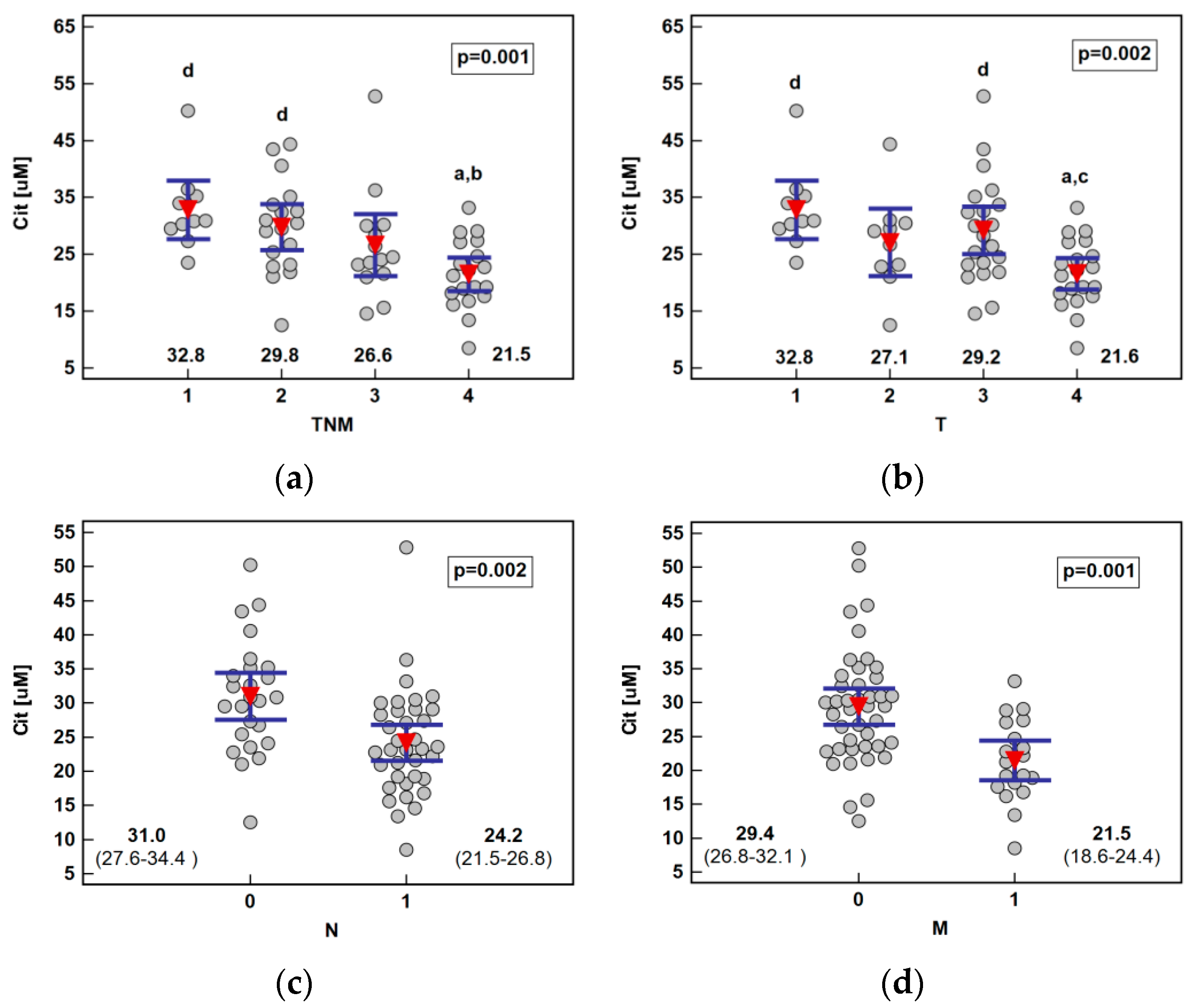

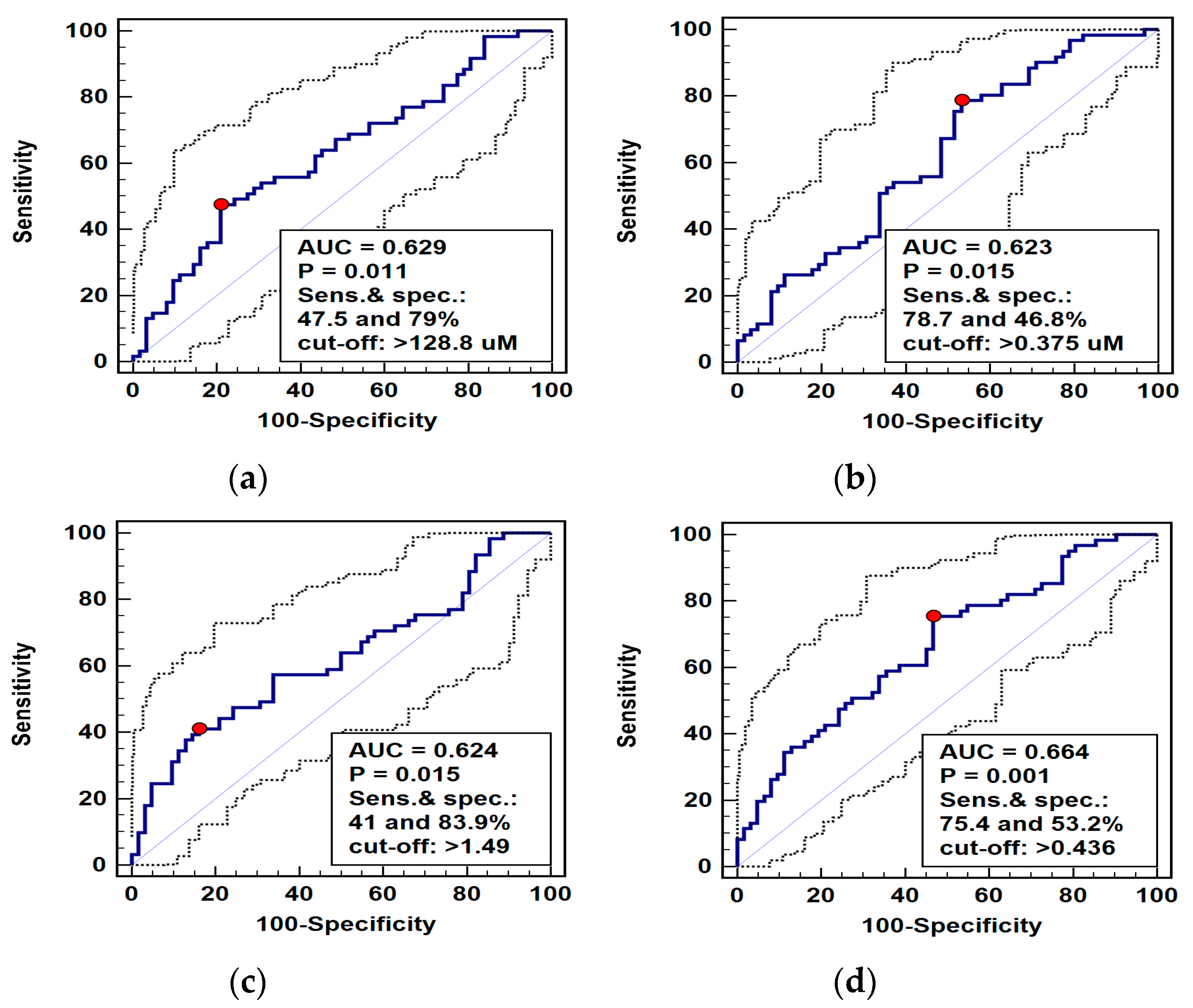
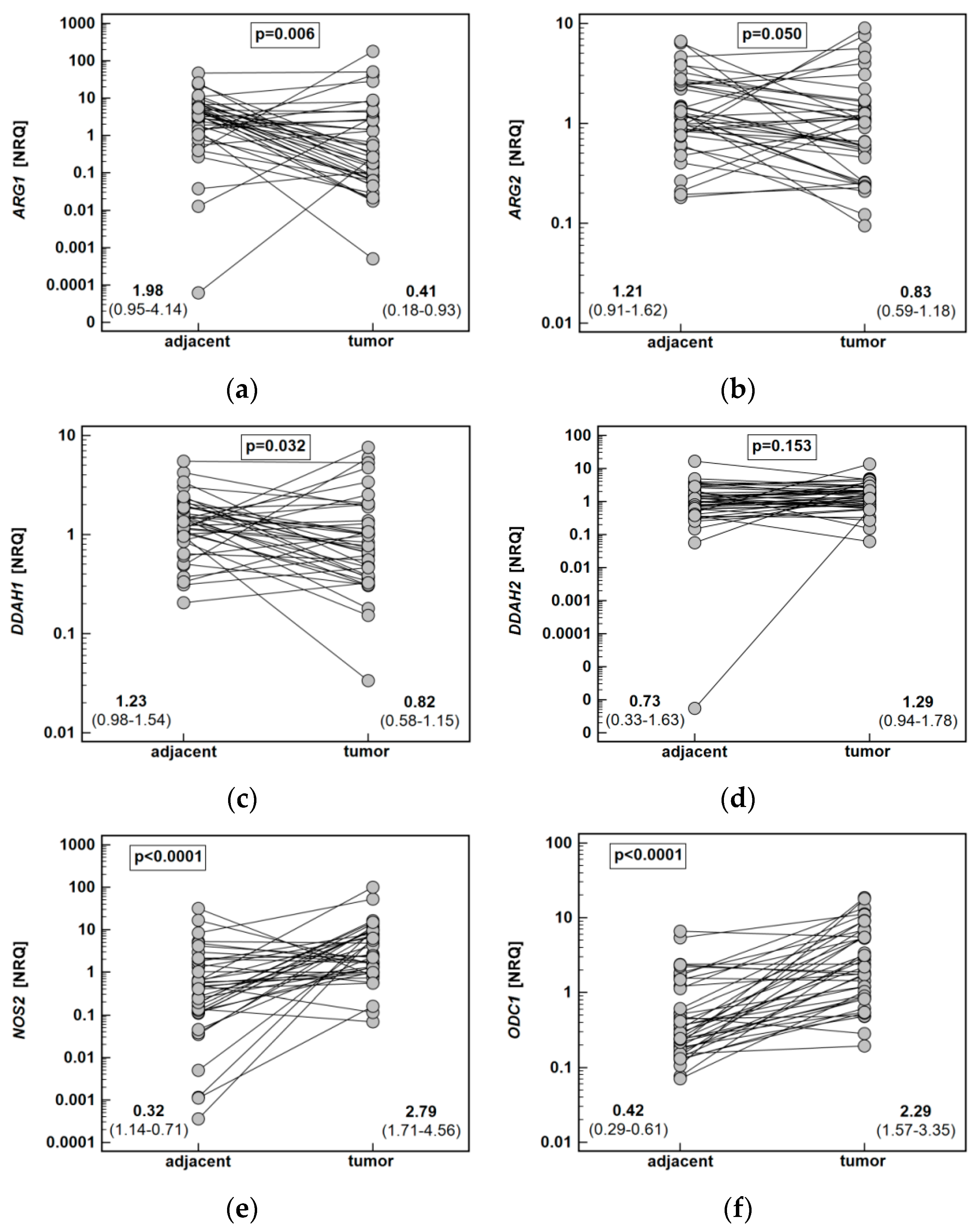
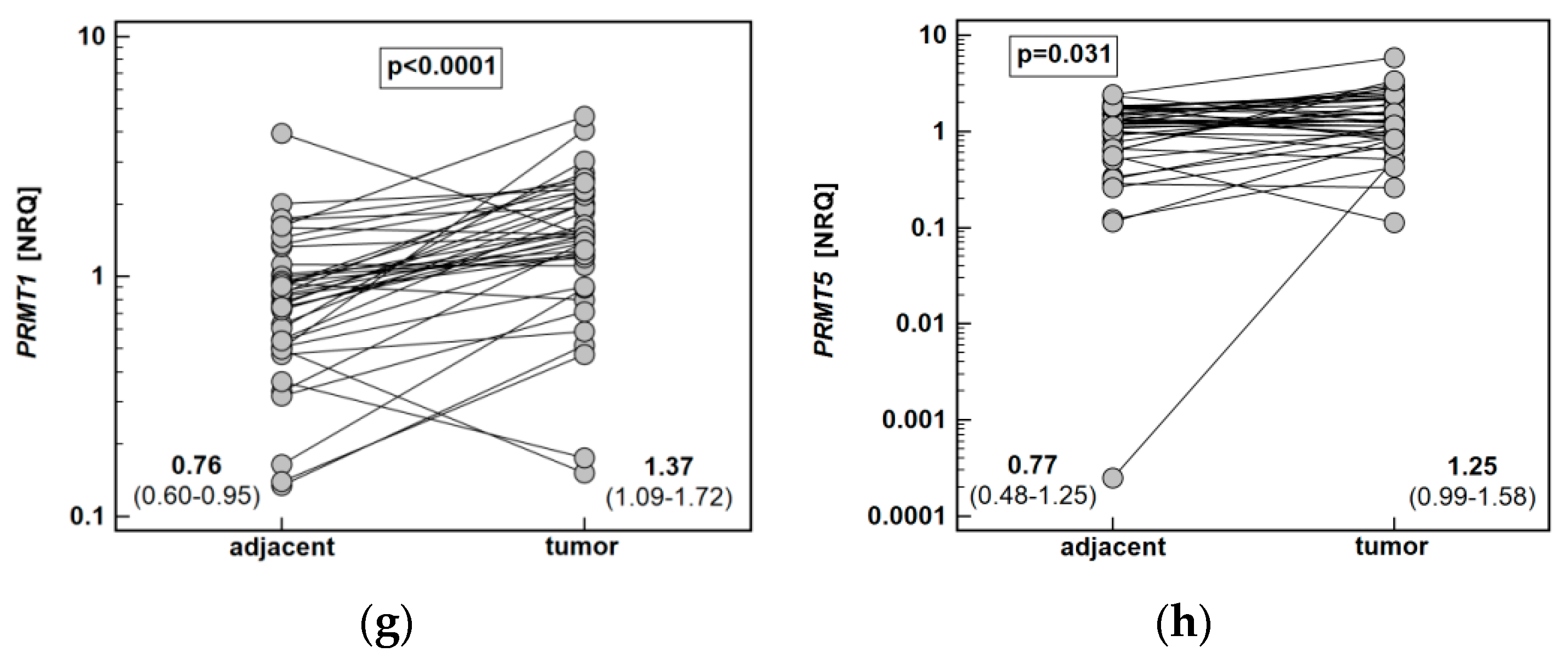
| Metabolite | ADMA | Arg | Cit | DMA | Orn | SDMA |
|---|---|---|---|---|---|---|
| Metabolites in ESCC patients | ||||||
| ADMA | x | 0.43 3 | 0.25 4 | 0.32 1 | 0.33 2 | 0.44 3 |
| Arg | 0.39 2 | x | 0.40 2 | - | - | 0.29 1 |
| Cit | 0.47 3 | 0.30 1 | x | - | - | - |
| DMA | 0.22 4 | - | 0.30 1 | x | - | 0.46 3 |
| Orn | 0.28 1 | - | 0.24 4 | - | x | 0.35 2 |
| SDMA | 0.35 2 | - | - | 0.45 3 | - | x |
| Metabolites in patients with benign diseases | ||||||
| Cytokine | Arg | Cit | Orn | ADMA | SDMA | DMA | A/ADMA | A/C+O |
|---|---|---|---|---|---|---|---|---|
| β-NGF | - | - | - | 0.31 1 | 0.42 2 | 0.32 1 | - | - |
| CTAK | - | - | - | 0.33 1 | 0.48 3 | - | - | 0.35 1 |
| EOX | - | 0.30 1 | - | - | - | - | - | - |
| FGF2 | - | −0.50 3 | - | - | - | - | - | - |
| G-CSF | - | −0.45 2 | - | - | - | - | - | - |
| GM-CSF | - | −0.54 3 | - | - | 0.33 1 | - | - | 0.28 4 |
| GROα | - | - | - | 0.49 3 | 0.42 2 | 0.34 1 | - | - |
| HGF | 0.42 2 | - | - | 0.31 1 | 0.34 1 | 0.41 2 | - | - |
| IFNα2 | - | - | - | 0.42 2 | 0.41 2 | 0.34 1 | - | - |
| IFNγ | - | −0.57 3 | - | - | - | - | - | - |
| IL-10 | - | −0.55 3 | - | - | - | - | - | - |
| IL-12p70 | - | −0.33 1 | - | - | - | - | −0.27 4 | - |
| IL-13 | - | −0.64 3 | - | - | 0.36 1 | 0.26 4 | - | - |
| IL-15 | - | −0.31 1 | - | - | 0.33 1 | - | - | - |
| IL-16 | - | - | - | - | 0.32 1 | 0.44 2 | - | - |
| IL-17 | - | −0.51 3 | - | - | 0.29 4 | - | - | 0.41 2 |
| IL-18 | 0.27 4 | - | 0.27 4 | 0.29 4 | 0.32 1 | - | - | |
| IL-1β | - | −0.45 2 | - | - | - | - | - | 0.32 1 |
| IL-1ra | - | −0.44 2 | - | - | - | - | - | - |
| IL-2Rα | - | - | - | 0.40 2 | 0.26 1 | 0.38 2 | −0.29 4 | - |
| IL-3 | - | - | - | 0.40 2 | 0.45 2 | 0.39 3 | - | - |
| IL-4 | - | −0.38 2 | - | - | - | - | - | - |
| IL-5 | - | −0.54 3 | - | - | - | - | - | - |
| IL-6 | - | −0.35 1 | - | - | - | - | - | - |
| IL-7 | - | - | −0.51 3 | - | - | - | - | 0.39 2 |
| IL-8 | - | −0.44 2 | - | - | - | - | - | - |
| IL-9 | - | −0.26 4 | - | - | 0.27 4 | - | - | - |
| IP-10 | - | - | - | - | 0.45 2 | - | - | - |
| LIF | - | −0.29 1 | - | - | 0.47 2 | 0.38 2 | - | 0.27 4 |
| MCP-1 | 0.30 1 | - | - | - | 0.29 1 | - | - | - |
| MIF | - | −0.37 1 | 0.30 1 | - | - | - | −0.32 1 | −0.32 1 |
| MIG | - | - | - | 0.25 4 | 0.34 1 | - | - | - |
| MIP-1α | - | −0.33 1 | - | - | 0.45 2 | - | - | - |
| MIP-1β | - | −0.55 3 | - | - | 0.31 1 | 0.31 1 | - | - |
| PDGF-BB | 0.32 1 | - | - | - | 0.26 4 | 0.27 4 | 0.33 1 | - |
| SCF | 0.30 1 | - | - | 0.28 4 | 0.54 3 | 0.64 3 | - | - |
| SCGF-β | - | - | - | - | 0.45 2 | 0.49 3 | - | - |
| SDF-1α | - | - | - | 0.35 1 | 0.37 1 | 0.31 1 | - | - |
| TNFα | 0.36 1 | −0.51 3 | - | - | 0.27 4 | - | - | 0.31 1 |
| TRAIL | 0.47 3 | - | - | 0.43 2 | - | 0.48 3 | - | 0.28 4 |
| VEGF-A | - | −0.26 4 | - | - | - | - | −0.35 1 | - |
| Pathology | Expression Ratio (Tumor-to-Adjacent) | |||||||
|---|---|---|---|---|---|---|---|---|
| ARG1 | ARG2 | DDAH1 | DDAH2 | NOS2 | ODC1 | PRMT1 | PRMT5 | |
| TNM 1 | ns | ns | ns | ρ = −0.43, p = 0.006 | ns | ρ = −0.46, p = 0.003 | ns | ρ = −0.33, p = 0.039 |
| T 1 | ns | ns | ns | ρ = −0.31, p = 0.051 | ns | ρ = −0.39, p = 0.012 | ns | ns |
| N1 vs. N0 2 | 0.14 vs. 0.33, p = 0.420 | 0.5 vs. 0.97, p = 0.080 | 0.5 vs. 0.91, p = 0.110 | 0.94 vs. 3.6, p = 0.092 | 4.1 vs. 20.3, p = 0.090 | 3.8 vs. 8.1, p = 0.079 | 1.5 vs. 2.3, p = 0.039 | 1.1 vs. 2.5, p = 0.056 |
| M1 vs. M0 2 | 0.07 vs. 0.24, p = 0.465 | 0.69 vs. 0.68, p = 0.987 | 0.46 vs. 0.7, p = 0.474 | 0.74 vs. 2, p = 0.408 | 21.1 vs. 7.7, p = 0.487 | 1.6 vs. 6.5, p = 0.032 | 2 vs. 1.8, p = 0.788 | 1.3 vs. 1.7, p = 0.671 |
| Pathology | Relative Gene Expression in Tumors (NRQ) | |||||||
|---|---|---|---|---|---|---|---|---|
| ARG1 | ARG2 | DDAH1 | DDAH2 | NOS2 | ODC1 | PRMT1 | PRMT5 | |
| TNM 1 | ns | ns | ns | ns | ns | ρ = −0.28, p = 0.082 | ns | ns |
| T 1 | ns | ns | ns | ns | ns | ns | ns | ns |
| N1 vs. N0 2 | 0.39 vs. 0.42, p = 0.909 | 0.74 vs. 0.94, p = 0.503 | 0.63 vs. 1.1, p = 0.119 | 1.1 vs. 1.6, p = 0.239 | 2.3 vs. 3.5, p = 0.344 | 2 vs. 2.7, p = 0.468 | 1.2 vs. 1.6, p = 0.220 | 1.1 vs. 1.4, p = 0.383 |
| M1 vs. M0 2 | 0.28 vs. 0.43, p = 0.743 | 1.1 vs. 0.8, p = 0.568 | 0.95 vs. 0.8, p = 0.743 | 1.2 vs. 1.3, p = 0.895 | 11.6 vs. 2.3, p = 0.024 | 0.76 vs. 2.7, p = 0.023 | 1.7 vs. 1.3, p = 0.444 | 1.6 vs. 1.2, p = 0.479 |
| Pathology | Relative Gene Expression in Noncancerous Tumor Adjacent Tissue (NRQ) | |||||||
|---|---|---|---|---|---|---|---|---|
| ARG1 | ARG2 | DDAH1 | DDAH2 | NOS2 | ODC1 | PRMT1 | PRMT5 | |
| TNM 1 | ns | ρ = 0.34, p = 0.034 | ns | ρ = 0.28, p = 0.084 | ns | ρ = 0.30, p = 0.061 | ns | ns |
| T 1 | ns | ρ = 0.29, p = 0.069 | ns | ns | ns | ns | ns | ns |
| N1 vs. N0 2 | 2.9 vs. 1.3, p = 0.300 | 1.5 vs. 0.97, p = 0.143 | 1.3 vs. 1.2, p = 0.797 | 1.1 vs. 0.44, p = 0.238 | 0.55 vs. 0.18, p = 0.145 | 0.54 vs. 0.33, p = 0.185 | 0.82 vs. 0.69, p = 0.442 | 1 vs. 0.56, p = 0.200 |
| M1 vs. M0 2 | 4 vs. 1.8, p = 0.088 | 1.6 vs. 1.2, p = 0.499 | 2.1 vs. 1.2, p = 0.085 | 1.7 vs. 0.7, p = 0.446 | 0.55 vs. 0.3, p = 0.610 | 0.48 vs. 0.4, p = 0.808 | 0.88 vs. 0.74, p = 0.610 | 1.2 vs. 0.72, p = 0.463 |
| Gene | ARG1 | ARG2 | DDAH1 | DDAH2 | NOS2 | ODC1 | PRMT1 | PRMT5 |
|---|---|---|---|---|---|---|---|---|
| ARG1 | 0.40 1 | 0.36 1 | 0.53 3 | - | 0.51 3 | - | - | |
| ARG2 | 0.43 2 | 0.46 2 | - | 0.47 2 | 0.34 1 | 0.58 3 | ||
| DDAH1 | 0.62 3 | - | - | 0.48 2 | 0.32 1 | |||
| DDAH2 | 0.27 4 | 0.38 1 | 0.74 3 | 0.57 3 | ||||
| NOS2 | - | 0.42 2 | 0.47 2 | |||||
| ODC1 | - | 0.46 2 | ||||||
| PRMT1 | 0.63 3 |
| Gene | ARG1 | ARG2 | DDAH1 | DDAH2 | NOS2 | ODC1 | PRMT1 | PRMT5 |
|---|---|---|---|---|---|---|---|---|
| ARG1 | 0.43 2 | 0.50 3 | - | - | - | - | 0.47 2 | |
| ARG2 | 0.45 2 | 0.53 3 | - | 0.59 3 | 0.60 3 | 0.63 3 | ||
| DDAH1 | 0.51 3 | - | - | 0.66 3 | 0.66 3 | |||
| DDAH2 | - | 0.55 3 | 0.69 3 | 0.63 3 | ||||
| NOS2 | 0.55 3 | 0.33 1 | - | |||||
| ODC1 | 0.50 3 | 0.36 1 | ||||||
| PRMT1 | 0.87 3 |
| ARG1 | ARG2 | DDAH1 | DDAH2 | NOS2 | ODC1 | PRMT1 | PRMT5 | |
|---|---|---|---|---|---|---|---|---|
| ADMA | 0.29 3 | - | - | - | - | - | −0.49 2 | - |
| Arg | 0.29 3 | - | - | - | - | - | - | - |
| Cit | - | 0.29 3 | - | - | - | - | - | - |
| SDMA | - | 0.30 3 | - | - | - | - | - | - |
| Orn | - | - | −0.39 1 | - | - | - | - | - |
| FGF2 | - | - | −0.39 1 | - | - | - | - | - |
| HGF | 0.40 1 | - | - | - | - | - | - | - |
| G-CSF | - | - | - | - | 0.29 3 | - | - | - |
| IL-3 | 0.29 3 | 0.30 3 | - | - | - | - | - | - |
| IL-4 | - | - | - | - | 0.44 2 | - | - | - |
| IL-5 | - | - | - | - | 0.41 1 | - | - | 0.29 3 |
| IL-6 | - | - | - | - | 0.41 1 | - | - | 0.31 3 |
| IL-7 | - | - | - | - | - | - | - | - |
| IL-8 | - | - | - | - | 0.31 3 | - | - | - |
| IL-16 | - | 0.29 3 | - | - | - | - | - | - |
| IL-17 | - | −0.29 3 | - | - | - | - | - | - |
| IL-18 | 0.39 1 | - | - | - | - | - | - | - |
| IFNγ | - | - | - | - | 0.31 3 | - | - | - |
| IFNα2 | - | - | - | - | - | 0.31 3 | - | - |
| MCP-1 | - | - | - | - | - | 0.35 1 | - | - |
| SDF-1α | - | 0.34 1 | - | - | - | - | - | - |
| TRAIL | - | 0.32 3 | - | - | - | - | - | - |
| VEGF-A | - | −0.31 3 | - | - | - | - | - | - |
| ARG1 | ARG2 | DDAH1 | DDAH2 | NOS2 | ODC1 | PRMT1 | PRMT5 | |
|---|---|---|---|---|---|---|---|---|
| ADMA | 0.29 4 | - | - | - | - | - | - | - |
| FGF2 | −0.29 4 | - | - | - | - | - | - | - |
| G-CSF | - | −0.28 4 | - | - | - | - | - | - |
| GM-CSF | −0.29 4 | - | - | - | - | - | - | - |
| GROα | −0.32 4 | - | - | - | - | - | - | - |
| HGF | −0.39 1 | - | - | - | - | - | - | - |
| IL-3 | - | - | - | - | 0.37 1 | 0.30 4 | - | - |
| IL-4 | - | - | - | - | - | - | 0.31 4 | 0.32 4 |
| IL-5 | - | - | - | 0.33 4 | - | - | 0.33 4 | 0.33 1 |
| IL-6 | - | - | - | - | - | - | - | - |
| IL-7 | - | - | - | - | - | - | 0.33 4 | 0.37 1 |
| IL-8 | - | - | - | - | - | - | 0.30 4 | - |
| IL-9 | - | - | - | 0.34 1 | 0.40 1 | 0.33 4 | - | - |
| IL-13 | −0.33 4 | - | - | - | - | - | - | - |
| IL-15 | - | - | - | - | 0.29 4 | - | - | - |
| IL-16 | −0.33 4 | - | - | - | - | 0.30 4 | - | - |
| IL-18 | - | - | - | - | - | 0.37 1 | - | - |
| IL-2Rα | −0.35 1 | - | - | - | - | 0.29 4 | - | - |
| IFNα2 | - | - | - | - | - | 0.32 4 | - | - |
| IP-10 | - | - | - | 0.34 1 | - | - | - | - |
| LIF | −0.29 4 | - | - | 0.45 2 | 0.38 1 | 0.53 3 | 0.28 4 | - |
| MCP-1 | - | - | - | - | 0.30 4 | - | - | - |
| MIP-1β | - | 0.36 1 | - | 0.30 4 | - | 0.38 1 | 0.37 1 | 0.38 1 |
| RANTES | - | - | −0.30 4 | - | 0.28 4 | 0.45 2 | - | - |
| SCGFβ | - | - | - | 0.34 1 | - | - | 0.29 4 | - |
| SDF-1α | - | - | - | - | 0.29 4 | - | - | - |
| SCF | - | - | - | - | - | 0.41 1 | - | - |
| TNFα | - | - | - | 0.28 4 | - | - | 0.30 4 | - |
| TRAIL | - | - | - | - | - | 0.33 4 | - | - |
| Parameter | Benign | ESCC | p-Value |
|---|---|---|---|
| N | 62 | 61 | - |
| Sex (F/M), n | 26/36 | 24/37 | 0.855 1 |
| Age [y], mean ± SD | 61.5 ± 10.2 | 60.4 ± 7.3 | 0.509 2 |
| TNM (I/II/III/IV), n | - | 10/18/14/19 | - |
| T (1/2/3/4), n | - | 10/10/21/20 | - |
| N (0/≥1), n | - | 25/36 | - |
| M (0/1), n | - | 42/19 | - |
| Parameter | ESCC |
|---|---|
| N | 40 |
| Sex (F/M), n | 15/25 |
| Age [y], mean ± SD | 57.9 ± 6.9 |
| Stage (I/II/III/IV) | 3/12/19/5 |
| Primary tumor, T (1/2/3/4) | 2/11/20/7 |
| Lymph node metastasis, N (no/yes) | 19/21 |
| Distant metastasis, M (no/yes) | 35/5 |
| Gene | Name | Accession No. | Primer sequence 5′→3′ | Size [bp] |
|---|---|---|---|---|
| ARG11 | Arginase-1 | NM_001244438.2 | F: tcatctgggtggatgctcacac R: gagaatcctggcacatcgggaa | 130 |
| ARG21 | Arginase-2 | NM_001172.4 | F: ctggcttgatgaaaaggctctcc R: tgagcgtggattcactatcaggt | 119 |
| NOS21 | Inducible nitric oxide synthase | NM_000625.4 | F: gctctacacctccaatgtgacc R: ctgccgagatttgagcctcatg | 136 |
| ODC11 | Ornithine decarboxylase | NM_002539.3 | F: ccaaagcagtctgtcgtctcag R: cagagattgcctgcacgaaggt | 162 |
| PRMT11 | Arginine N-methyltransferase-1 | NM_001536.5 | F: tgcggtgaagatcgtcaaagcc R: ggactcgtagaagaggcagtag | 142 |
| PRMT51 | Arginine N-methyltransferase-5 | NM_006109.5 | F: ctagaccgagtaccagaagagg R: cagcatacagctttatccgccg | 136 |
| DDAH11 | Dimethylarginine dimethylaminohydrolase-1 | NM_012137.4 | F: atgcagtctccacagtgccagt R: ttgtcgtagcggtggtcactca | 151 |
| DDAH21 | Dimethylarginine dimethylaminohydrolase-2 | NM_001303007.2 | F: ctttcttcgtcctgggttgcct R: ctccagttctgagcaggacaca | 136 |
| GAPDH2 | Glyceraldehyde-3-phosphate dehydrogenase | NM_001256799.3 | F: tagattattctctgatttggtcgtattgg R: gctcctggaagatggtgatgg | 223 |
© 2020 by the authors. Licensee MDPI, Basel, Switzerland. This article is an open access article distributed under the terms and conditions of the Creative Commons Attribution (CC BY) license (http://creativecommons.org/licenses/by/4.0/).
Share and Cite
Bednarz-Misa, I.; Fortuna, P.; Fleszar, M.G.; Lewandowski, Ł.; Diakowska, D.; Rosińczuk, J.; Krzystek-Korpacka, M. Esophageal Squamous Cell Carcinoma Is Accompanied by Local and Systemic Changes in L-arginine/NO Pathway. Int. J. Mol. Sci. 2020, 21, 6282. https://doi.org/10.3390/ijms21176282
Bednarz-Misa I, Fortuna P, Fleszar MG, Lewandowski Ł, Diakowska D, Rosińczuk J, Krzystek-Korpacka M. Esophageal Squamous Cell Carcinoma Is Accompanied by Local and Systemic Changes in L-arginine/NO Pathway. International Journal of Molecular Sciences. 2020; 21(17):6282. https://doi.org/10.3390/ijms21176282
Chicago/Turabian StyleBednarz-Misa, Iwona, Paulina Fortuna, Mariusz G. Fleszar, Łukasz Lewandowski, Dorota Diakowska, Joanna Rosińczuk, and Małgorzata Krzystek-Korpacka. 2020. "Esophageal Squamous Cell Carcinoma Is Accompanied by Local and Systemic Changes in L-arginine/NO Pathway" International Journal of Molecular Sciences 21, no. 17: 6282. https://doi.org/10.3390/ijms21176282
APA StyleBednarz-Misa, I., Fortuna, P., Fleszar, M. G., Lewandowski, Ł., Diakowska, D., Rosińczuk, J., & Krzystek-Korpacka, M. (2020). Esophageal Squamous Cell Carcinoma Is Accompanied by Local and Systemic Changes in L-arginine/NO Pathway. International Journal of Molecular Sciences, 21(17), 6282. https://doi.org/10.3390/ijms21176282






